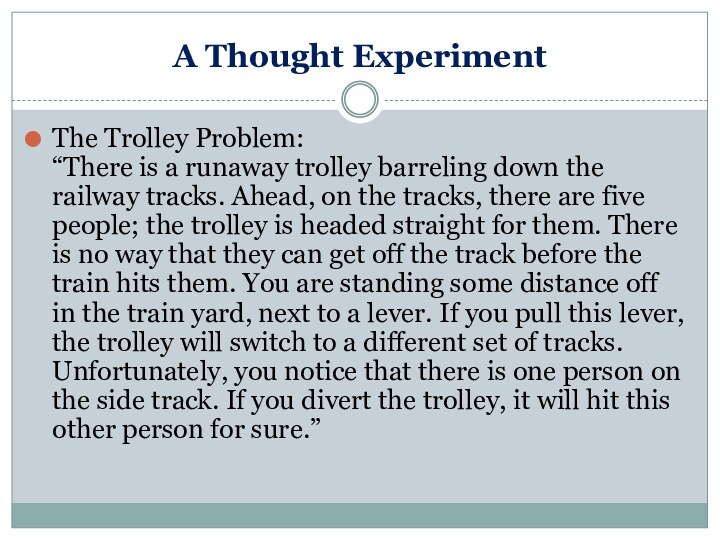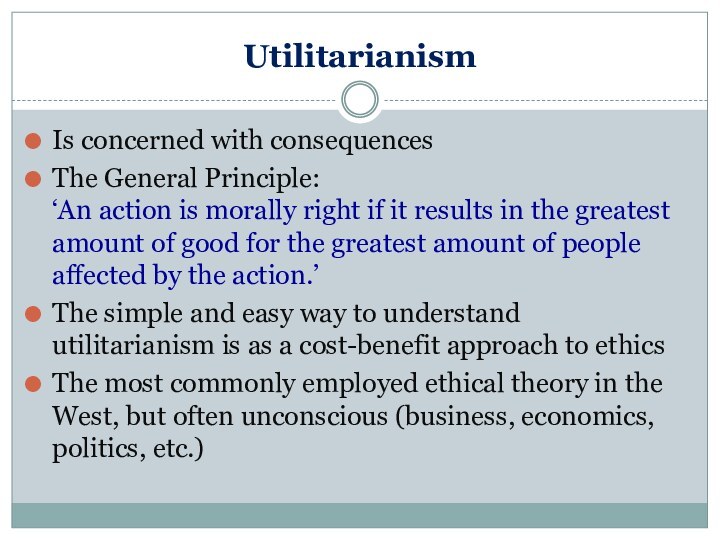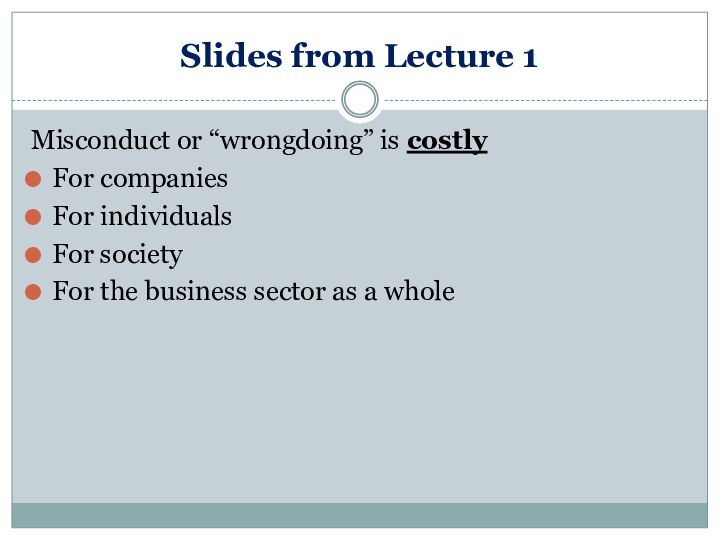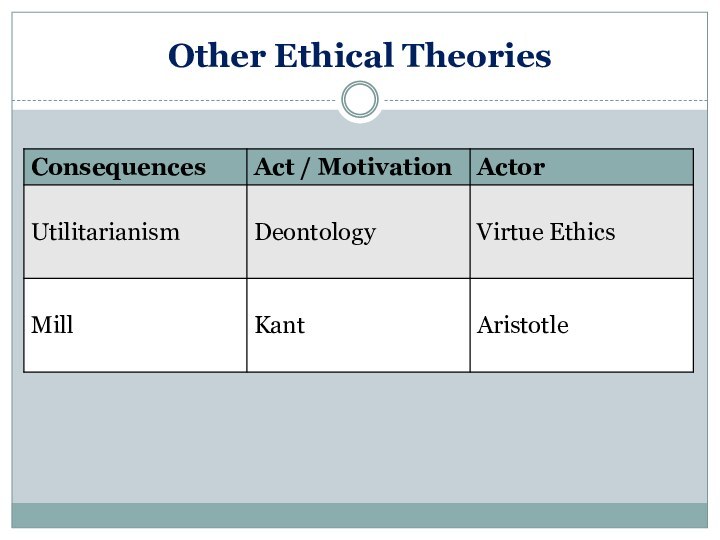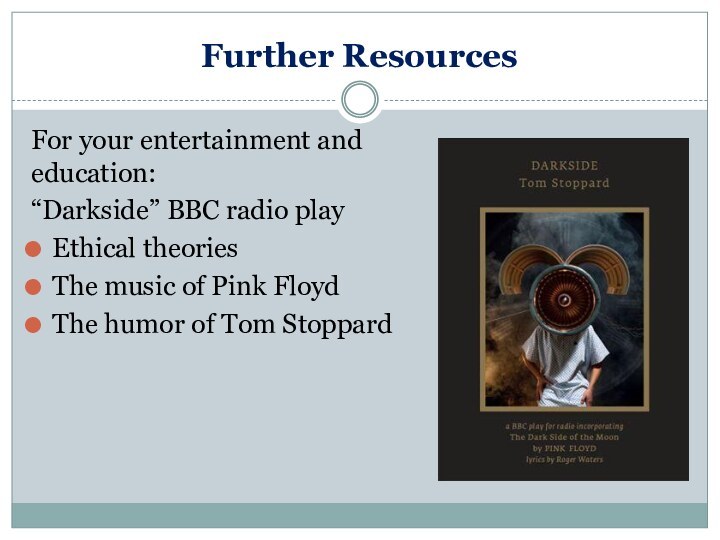Слайд 2
Ethical Theories and Business Ethics
Слайд 3
Morality, Ethics and Ethical Theory
According to the textbook:
“Morality
is concerned with the norms, values and beliefs embedded
in social processes which define right and wrong for an individual or a community.”
“Ethics is concerned with the study of morality and the application of reason to elucidate specific rules and principles that determine right and wrong for any given situation.”
“These rules and principles are called ethical theories.”
Слайд 4
Western Ethical Theories
Ancient Tradition: Greek and Roman Philosophers
like Plato and Aristotle
Christianity & Feudalism: Right and wrong
is decided by God. Popes and Kings (and their subordinates) have the authority to speak for God.
Enlightenment (17th – 18th century): Right and wrong should be decided by reason alone; rejection of tradition, and emotions.
Most modern Western ethical theories are rational (based on reason).
Слайд 5
Ethical Theory
A framework of rules and principles by
which we can distinguish right from wrong, or good
from bad, using reason.
Can be used to explain why someone thinks that something is right or wrong.
Can be used to justify actions.
Can be applied to evaluate the actions of individuals and firms.
Слайд 6
A Thought Experiment
The Trolley Problem:
nytimes.com
Слайд 7
A Thought Experiment
The Trolley Problem:
“There is a runaway
trolley barreling down the railway tracks. Ahead, on the
tracks, there are five people; the trolley is headed straight for them. There is no way that they can get off the track before the train hits them. You are standing some distance off in the train yard, next to a lever. If you pull this lever, the trolley will switch to a different set of tracks. Unfortunately, you notice that there is one person on the side track. If you divert the trolley, it will hit this other person for sure.”
Слайд 8
A Thought Experiment
You have two options: (1) Pull
the lever, diverting the trolley onto the side track
where it will kill one person. (2) Do nothing, and the trolley kills the five people on the main track.
What do you do?
nytimes.com
Слайд 9
Two Main Types of Ethical Theories
Motivation or
Principles
Action
Outcomes
Non-consequentialist ethics
The
Duty Ethics of Kant and Ethics of Rights and
Justice
Consequentialist ethics
Utilitarianism
Слайд 10
Utilitarianism
Is concerned with consequences
The General Principle:
‘An action is
morally right if it results in the greatest amount
of good for the greatest amount of people affected by the action.’
The simple and easy way to understand utilitarianism is as a cost-benefit approach to ethics
The most commonly employed ethical theory in the West, but often unconscious (business, economics, politics, etc.)
Слайд 11
Slides from Lecture 1
Misconduct or “wrongdoing” is costly
For
companies
For individuals
For society
For the business sector as a whole
Слайд 13
What is “Good”?
Happiness
Pleasure, freedom from pain
Utility
The motive is
irrelevant to
goodness
Only the outcome matters
John Stuart Mill
(1806-1873)
Слайд 14
Slide from Lecture 1
BUSINESS
Benefit
Harm
Maximize
Minimize
Слайд 15
Ethical Dilemma
Collusive efforts of local manufacturers have barred
the ROLL Bike company from entering a large Asian
market. ROLL’s management expects to net $10 million (USD) yearly from bicycle sales if it could penetrate the market. Last week a businessman from the country contacted ROLL’s management and assured them that he could smooth the way for the company to sell in his country for a ‘grease’ fee of $1 million.
Q: If you were responsible, would you pay the so-called ‘grease’ fee?
(Certainly not --- Don’t know --- Certainly yes)
Слайд 16
Victimless Crimes
Cheating on an exam
Paying a bribe
Is anyone
hurt by these actions?
Individual acts do not seem to
hurt anyone
Слайд 17
Victimless Crimes
Rule utilitarianism looks at a class of
actions and asks whether in principle it produces the
greatest amount of good for the greatest amount of people
Thus: What would happen if everyone cheated on their exams?
What if everyone engaged in bribery
The result would be more harm than good
Rule utilitarianism and act utilitarianism often lead to different conclusions
Слайд 18
Problems of Utilitarianism 1
How do we assign values
to (quantify) pleasure and pain?
How can we compare
one person’s happiness to another’s?
How can we compare one person’s pleasure to another’s pain?
Is everyone pleasure and pain equally valued?
Слайд 20
Ford Pinto Case
Recall & fix: Cost would be
$11 per vehicle, with 12.5 million vehicles needing to
be recalled. The total cost would be $137.5 million (and less trunk space).
Do nothing: Predicted 180 people could die, 180 people could suffer serious burns, and 2,100 vehicles could be destroyed by fire. Based on estimates, total cost would be $49.5 million (180 deaths x $200,000 + 180 serious burns x $67,000 + 2,100 vehicles x $700)
(Schwartz & Saiia, 2012)
Слайд 21
Problems of Utilitarianism 2
We can’t perfectly predict consequences
because future is unknown.
What if the one person in
the trolley example would have discovered a cure to cancer later in life?
What if one of the people who survives becomes a mass murderer?
Long vs. short term consequences: Sometimes these differ drastically
Слайд 22
Problems of Utilitarianism 3
Indifferent to the distribution of
good or happiness.
Could be used to justify things we
generally consider immoral, such as slavery or forced labor.
Problems of ends justifying the means.
Слайд 23
Utilitarianism
Note that utilitarianism is not egoism
Doing cost-benefit analysis
to think of how only you (or only your
company) will be affected is egoism (i.e. Ford Pinto).
Слайд 24
Movie Clip
Extreme Measures (1996)
Summary: A well-respected, older doctor
(Gene Hackman) has been working on cure to paralysis.
A young doctor (Hugh Grant) discovers that he has been experimenting on patients without their permission. He himself was briefly paralyzed.
Слайд 25
Ethics of Duty (Deontology)
Proposed by the 18th century
German philosopher Immanuel Kant
Focuses on defining the Categorical
Imperative: An ethical theory or law our acts must conform to under all conditions
Independent of consequences
a priori moral law
Immanuel Kant (1724-1804)
Слайд 26
Kant’s Three Maxims
Consistency – “Act only according to
that maxim by which you can at the same
time will that it should become a universal law”
Respect for human dignity – “Act so that you treat humanity, whether in your own person or in that of another, always as an end and never as a means only”
Universal acceptability – “Act only so that the will through its maxims could regard itself at the same time as universally lawgiving”
Слайд 27
Kant’s Three Maxims
Consistency – Apply the same standard
to your action that you would to others’. Don’t
make an exception for yourself.
Respect for human dignity – Don’t use others. Treat them as an end not as a means.
Universal acceptability – Act only as you would if your actions were known to all.
These are different formulations of one categorical imperative, according to Kant, and therefore equivalent.
Слайд 28
Kantian Ethics
Kant’s deontology sees each human being as
possessing intrinsic worth or dignity and deserving of respect
because each is an autonomous, thinking person capable of making moral choices
(Intrinsic = belonging to the essence of a thing, part of its reality; not having to be gained or earned)
Thus it is wrong to use others as a means to an end (Maxim 2).
Intentions matter: An act is only good if motivated by good intentions (good will, benevolence)
Слайд 29
Critiques of Deontology
No attention to consequences!
Overly rational. Overestimates
people’s ability to use reason to apply the three
maxims - many people struggle to understand and apply the three maxims.
Слайд 30
that we all have a duty to respect
these rights with regard to others (and have our
rights, in turn, respected)
Similar to Kantian ethics in its respect for individual’s dignity, but does not rely on rather complex philosophical arguments
Natural Rights theories simply posit everyone has certain rights that must not be violated simply by virtue of being human
For example, John Locke argued that
humans (by their very nature) have a right
to life, liberty and property, and thus,
John Locke (1632-1704)
Natural Rights
Слайд 31
Universal Human Rights
Both Kant and Locke, and various
other scholars, have informed current conceptions of human rights
For
example, the Universal Declaration of Human Rights (1948) states, “All human beings are born free and equal in dignity and rights. They are endowed with reason and conscience and should act towards one another in a spirit of brotherhood.”
It includes the right to life, liberty, security, property, equality before the law, freedom of thought, conscience and religion, and so on
Слайд 32
Problems of Rights
Different people’s rights can be in
conflict with no clear way to decide which to
prioritize.
Слайд 33
Ethics of Justice
Justice (as fairness) allows us to
decide between competing claims or rights
Justice relies on
the establishment of just systems
John Rawls proposed that a just system should
Guarantee basic human rights and freedoms
Ensure that even the worst-off are
better of than they would be other-
wise
Give equal access to positions of
authority and decision-making
John Rawls
Слайд 34
Rawls’ Original Position
Imagine all human beings were assembled
someplace before time. Suppose they had to create a
system to live in (social contract) but no one knew who they would be in life (Veil of Ignorance). In this condition people would be motivated to create a just system. Thus a just system would be one that the participants in this Original Position could agree to.
Слайд 35
Feminist Ethics
Critique the ethic of justice as being
male-centric, impersonal, and blind to needs and relationships
Carol Gilligan
proposed an ethic of care as an alternative, one more commonly used by women in
deciding what is right or wrong
The ethic of care is more attentive to
needs and to nurturing others rather
than upholding principles
However, it is often devalued or
unacknowledged due to male
dominance
Carol Gilligan
Слайд 37
Virtue Ethics
An act is morally right if
it
is what a virtuous person would
do
Unlike utilitarianism and duty-
based ethics, is not concerned
with identifying rules for
“ethical” behavior
Instead, is concerned with
developing the moral character of
the decision maker
Aristotle
Слайд 38
Virtue Ethics
Emphasizes virtuous character. The formation of a
virtuous character is the first step towards morally correct
behavior
Examples of virtues are Honesty, Loyalty, Moderation, Self-control
Virtues are like habits. Once cultivated, are employed automatically. No rational deliberation needed.
Слайд 39
Confucian Ethics
Derives from 儒家 (rújiā), known as Confucianism
in English
Originators: Confucius (孔子), Mencius (孟子), others
Similar to
Virtue Ethics
Strong focus on cultivating self and
being virtuous
Ultimate goal is to become a
jūnzǐ (君子)
Confucius (孔子)
Слайд 40
Confucian Ethics
Core Confucian virtues (dé 德):
Rén (仁): compassion,
benevolence, humaneness
Yì (義): Sense of rightness, righteousness
Following lǐ: norms,
protocols, rituals, etiquette, propriety
and also wisdom, reciprocity, trustworthiness and filial piety
Слайд 41
Confucian Ethics
Essence of Rén = “Golden Rule” (zhong
shu)
(1) weak form: people should not do
to others things that they do not want others to do to them
(2) strong form: one is obligated to help others to develop morally next to personal development
Reciprocity is important
Слайд 42
Confucian Ethics
Self-cultivation and refinement based on self-regulation (not
rule-based)
One’s action should conform to social norms of polite
conduct
Ethical behavior (duties) is determined by one’s social role, relationships to others
Hierarchy of relationships indicates which take precedence, from highest to lowest: “ruler and subject; father and son; husband and wife; elder and younger brother; friend and friend.”
Woods & Lamond, 2011
Слайд 43
Confucian Ethics
Filial piety (father-son) is the template for
other hierarchical relationships (boss-subordinate, company-employee)
Leaders should be moral
exemplars for followers and show benevolence and care
Followers should show loyalty and respect for authority
Importance of harmony and collective over individual needs (but harmony is not same as sameness)
Ip, 2009; Woods & Lamond, 2011
Слайд 44
Confucian Ethics
How and why matter: Motives and the
manner something is done is more important than what
is done
Profit-making is not bad unless done for selfish reasons
Woods & Lamond, 2011
Слайд 45
Critiques of Confucianism
Conservative tendency: maintenance of hierarchy, status
quo. Resistance to change unless from top.
Anti-egalitarian, opposed to
democracy
Collectivism may lead to the violation of individual rights
Harmony may lead to suppression of disagreement
Asymmetric/unequal reciprocity (power)
Paternalistic leadership can reduce self-determination
Слайд 46
Critiques of Confucianism
Some schools of Confucian thought encourage
a negative attitude toward women and hinder gender equality
Confucianism has been employed by oppressive regimes to ideologically legitimize their dominance over people, due to its emphasis on hierarchy
Ip, 2009; Woods & Lamond, 2011
Слайд 47
Combining Ethical Theories
Crane and Matten argue for pluralism
They
argue that we should recognize that each ethical theory
can shed light on certain aspects of an issue that others cannot. Thus by combining we gain more, and overcome the shortcomings of each.
Also argue that we should strive towards reaching a consensus on basic principles
Слайд 48
A Thought Experiment 2
As before, a trolley is
hurtling down a track towards five people. You are
on a bridge under which it will pass, and you can stop it by dropping a heavy weight in front of it. As it happens, there is a very fat man next to you – your only way to stop the trolley is to push him over the bridge and onto the track, killing him to save five. What do you do?
nytimes.com
Слайд 49
Further Resources
For your entertainment and
education:
“Darkside” BBC
radio play
Ethical theories
The music of Pink Floyd
The humor
of Tom Stoppard
Слайд 50
Summary of Today’s Lecture
Introduced you to a variety
of ethical theories
Distinguished between consequentialist, non-consequentialist and virtue ethics
Ethical
theories can be used to determine what might be good or bad about different business practices
It is best to combine them, as each one has limitations
Ethical theories are not enough to achieve ethical behavior






